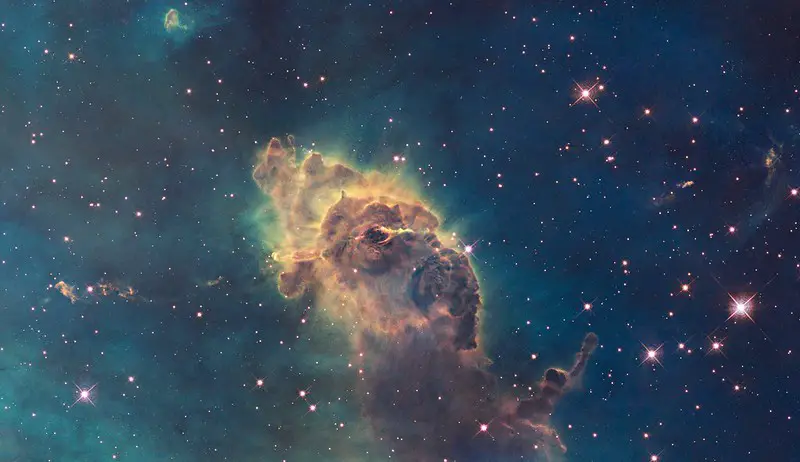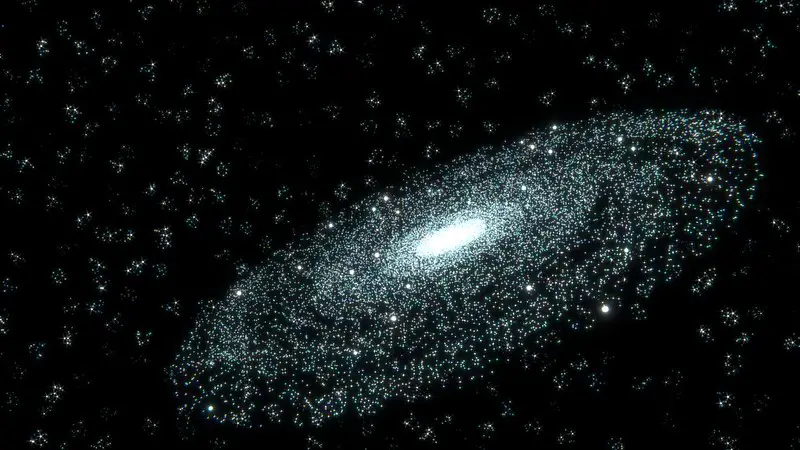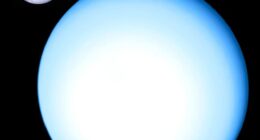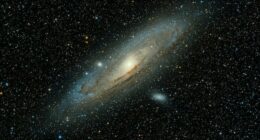Both nebulae and galaxies are fascinating structures in the vast expanse of space. Though they may seem similar at first glance, there are significant differences between them. Nebulae are clouds of gas and dust that can vary greatly in size and shape, whereas galaxies are massive systems containing billions of stars, gas, and dust held together by gravity.
What is a nebula?
(Photo By Robert Sullivan on Flickr)

A nebula is a vast cloud of gas and dust floating in space. These clouds are primarily made up of hydrogen, but they also contain other elements such as helium, carbon, and oxygen. The gas and dust that compose the nebulae can range in temperature from just a few degrees above absolute zero to tens of thousands of degrees Celsius.
Nebulae come in various shapes and sizes, with some spanning hundreds or even thousands of light-years across. They can be classified based on their appearance or composition. For example, some common types include emission nebulae – which glow due to ionized gases producing visible light – reflection nebulae that appear blue due to reflecting starlight off their dust particles.
These beautiful formations have been known throughout history by different cultures around the world but were only understood scientifically since the 19th century through advancements in telescopes and spectroscopy techniques.
Today astronomers continue to study these fascinating objects to learn more about how stars form within them and gain insights into our universe’s evolution over time.
What is a galaxy?
(Photo By kristian fagerström on Flickr)

A galaxy is a massive system of stars, planets, gas and dust held together by gravity. It’s like an island universe that contains billions or even trillions of stars. In fact, our own Milky Way Galaxy alone contains over 100 billion stars!
Galaxies come in different sizes and shapes. They can be spiral-shaped with long arms extending outwards from the center, elliptical-shaped with a smooth and round appearance, or irregularly shaped with no particular form.
One fascinating thing about galaxies is that they’re not stagnant – they’re constantly moving and changing over time. They collide and merge with other galaxies to create new formations or disturbances within existing ones.
Scientists believe that there could be as many as two trillion galaxies in the observable universe! It’s incredible to think about just how vast our universe really is, but studying these incredible systems can teach us so much about the inner workings of space itself.
Nebula Vs. Galaxy – Key differences
Nebulae and galaxies are two of the most fascinating objects in the universe. While they share some similarities, there are also key differences between them that set them apart.
One of the biggest differences between nebulae and galaxies is their size. Nebulae are relatively small compared to galaxies, typically only a few light years across. On the other hand, galaxies can be massive structures spanning hundreds of thousands or even millions of light years.
Another difference is their composition. Nebulae consist mostly of gas and dust, while galaxies contain stars, planets, dark matter, and more.
Nebulae also have a much shorter lifespan than galaxies. They form when clouds of gas collapse under their own gravity and eventually dissipate over time as new stars form within them. Galaxies on the other hand can survive for billions of years due to their sheer size and complexity.
While both nebulae and galaxies are awe-inspiring sights in our universe each has its unique characteristics that sets it apart from one another!
Types of galaxies
There are three main types of galaxies: spiral, elliptical, and irregular. Spiral galaxies have a distinct central bulge with arms that spiral outwards. They often contain younger stars and are actively forming new ones. The Milky Way is an example of a spiral galaxy.
Elliptical galaxies, on the other hand, lack any sort of structure and appear as smooth blobs in space. They tend to be older than other types of galaxies and have little to no star formation occurring within them.
Irregular galaxies are characterized by their chaotic shapes and lack of symmetry. They do not fit into either category above due to the absence of any distinct features or structures. Many irregular galaxies were once spirals or ellipticals but collided with another galaxy causing their shape to become distorted.
All three types come in various sizes ranging from dwarf to giant depending on the number of stars they contain. Galaxies can also be grouped together in clusters containing hundreds or even thousands of individual members!
How many nebulas are in a galaxy?
The number of nebulas in a galaxy can vary greatly depending on the type and size of the galaxy. Generally, spiral galaxies like our Milky Way have more nebulas than elliptical galaxies.
In fact, there are estimated to be thousands of nebulae within the Milky Way alone! These range from small, faint clouds to massive structures like the Orion Nebula.
But it’s not just spiral galaxies that contain nebulae – even irregular and dwarf galaxies can have them too. The Large Magellanic Cloud, a satellite galaxy of the Milky Way, is home to several known nebulae.
Interestingly, astronomers believe that many of these galactic nebulae were formed by supernova explosions – when massive stars reach the end of their lives and explode in a spectacular fashion.
While it can be difficult to determine an exact count for how many nebulas exist within a given galaxy due to their vastness and variety, we know that they are present in abundance throughout our universe.
Do galaxies form from nebulae?
Galaxies are vast clusters of stars, planets, and other celestial objects. On the other hand, nebulae are clouds of gas and dust in space that can give birth to stars and planets. But do galaxies form from nebulae?
The answer is yes! In fact, most galaxies including our own Milky Way galaxy were formed from the collapse of giant molecular clouds or nebulae.
As these massive clouds begin to shrink under gravity over millions of years, they break apart into smaller pieces that eventually become individual stars. As more and more stars form within a region, it begins to glow brightly with light- giving rise to what we know as a galaxy.
However, not all galaxies have the same origin story. Some small galaxies may have been created by collisions between larger ones while others could have come together due to gravitational interactions between groups of stars.
Regardless of how they came into existence though, one thing is certain – the beauty and wonderment of both galaxies and their cosmic origins continue to fascinate astronomers worldwide.
Is the Milky Way in a nebula?
Many people are fascinated by the beauty of the Milky Way, but few know whether it is located inside a nebula or not. The answer to this question is yes and no.
Firstly, let’s define what a nebula actually is. A nebula is a cloud of gas and dust in space that can be observed from Earth with telescopes. There are various types of nebulae, such as emission, reflection and dark nebulae.
The Milky Way itself contains several types of nebulae within its spiral arms. For example, the Eagle Nebula is located in one of the Milky Way’s spiral arms. It also contains other well-known objects like the Orion Nebula and Carina Nebula.
However, even though our galaxy does contain some nebulas within its structure, it cannot be classified as being “inside” a single massive nebulous cloud. This means that while there are indeed many small-scale nebulas present within our galaxy’s structure – they do not form an all-encompassing cloud around it.
Although the Milky Way does contain some beautiful examples of nebulas within its boundaries – we cannot classify it as being fully immersed in any single type or classification thereof!
Can we go inside nebula?
Nebulae are fascinating astronomical phenomena that have always captured the imagination of people. They are vast clouds of gas and dust in space, where stars are born. Many people wonder whether we can go inside a nebula.
The simple answer is no. Nebulae are not dense enough to accommodate human exploration. Although these formations appear massive from afar, they contain very few particles per cubic centimeter – much less than the air we breathe on Earth.
Moreover, nebulas do not have defined boundaries; instead, they gradually diffuse into surrounding space, making it almost impossible to pinpoint their edges or enter them without damaging sensitive scientific equipment.
However, recent technological advancements allow us to study nebulae more closely using telescopes and rovers equipped with sophisticated sensors and cameras. These tools enable us to learn more about the composition and properties of these breathtaking structures without risking human life or disturbing their delicate balance.
While visiting a nebula directly may remain out of reach for humans for now – there is still so much we can discover by studying them through other means!
Featured Image By – NASA Goddard Space Flight Center on Flickr









1 comment
The interstellar galaxy’s are A magnetic fridge. Because,as I assume they are vaporizing the nearest exotic element’s by heating it and then they are making them to be as cold as it gets. So to summarize my further comment about it, as had already been said the below is above and the above is below 👇👇👇 and I think you for being such an amazing intelligent people.
Please keep up your good work and continue to inform us about this matter of course.
I appreciate you so very proud of you ❤️❤️🌄 you have a wonderful and special celebration for the forthcoming Comet countdown.